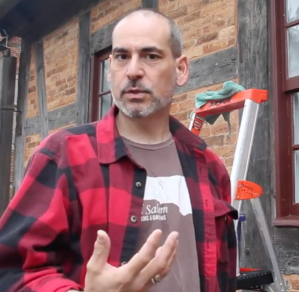The Discomfort You’re Feeling
Posted: March 30, 2020 Filed under: AAM, Communication, Community, Leadership, Museum, Nonprofit Leadership, Organizational Values | Tags: empathy, Leadership Matters, teamwork, transparency 3 Comments
This week I had “lunch” with my friend Franklin Vagnone, president of Winston Salem’s Old Salem Village in North Carolina. Frank had finished his first virtual (and emotionally draining) meeting at 8:00 am, so for him noon felt like late afternoon. As someone who was a museum leader in Philadelphia and then New York City through 9/11 and Hurricane Sandy, he’s not unfamiliar with leading in crisis. But like many museum leaders in the age of COVID-19, his Thursday began with planning for temporary layoffs for hourly staff. The layoffs are necessary because they allow staff to collect unemployment until the country emerges from the pandemic and Old Salem rights itself. Vagnone isn’t alone. Last week layoffs were announced by the Carnegie Museums in Pittsburgh, Seattle’s Science Center, and Philadelphia’s Franklin Institute, Science Center and Please Touch Museum, in addition to Colonial Williamsburg, San Francisco’s MOMA and undoubtedly many more. Sadly, the group most affected is the most vulnerable: part-time employees, many without benefits. As another friend put it, “Suddenly work is like trying to wash the dishes only the kitchen sink is missing and the water’s turned off.”
AAM’s President and CEO Laura Lott estimates that since the crisis began, museums collectively have lost $33 million a day. And whether planned or not, the museum world responded with 33,000 messages to Congress supporting AAM’s crisis request for $4 billion dollars, an amount which sent Fox and Friends into gales of laughter as if the arts weren’t a business, and a home-grown one at that. In the end, thanks to AAM’s tireless work, museums and arts organizations were included in the bill although not at levels that make them whole. You can find a full description here, including the full bill if you’re so inclined.
So what should you as a museum person, leader, or organization do?
As an individual:
-
- Take care of yourself and your loved ones.
- Maintain social distancing. Wash your hands. COVID-19 dislikes soap and water.
- If you’ve been laid off, don’t delay, apply for unemployment.
- If you’re working from home, there are many sites to support you, Here are a few good articles from last week: The Muse; Museum 2.0; The Atlantic.
- Stop looking at your screen. Take a walk. Do the reading you always meant to do, but put off.
- Plan for the future. Try to imagine, what things you want to keep and nurture, and what things you’ll change in a post-COVID-19 world.
As leader of a team or a department:
-
- Take care of your people. This will end, and re-hiring is costly. Protect staff in whatever way you can. If temporary layoffs while maintaining health insurance works for your museum, do it.
- Make sure everyone–board members, staff and volunteers–has the tools to communicate. Help them learn to stay in touch.
- Sort out communication methods that are most equitable. Offer tutorials to everyone, and encourage your team or department to talk with one another on a regular basis.
- Treasure your IT and social media team and build bridges between them and your program.
- Talk to your community, whether through email, Instagram or Facebook let them know you’re there.
As a Museum Leader:
-
- Thank your Congressional representatives.
- If you’re not an AAM member, join now. Its COVID-19 information is worth the individual membership if you can’t afford more. Ditto your regional museum service organization.
- Take care of your people. This will end, and re-hiring is costly. Protect staff in whatever way you can. If temporary layoffs, while maintaining health insurance works for your museum, do it. Don’t let HR make decisions because that’s the way it’s always done. We moved out of the world we knew about two weeks ago.
- Think about your organization’s virtual life. If you can create “A Minute with the Curator” or “A Walk with the Farm Horse” videos they may generate an audience that will outlive the virus. We’ve all watched Tim, the head of security at the National Cowboy Museum. Perhaps you have someone on your staff who’s equally charming and authentic, but never heard from.
- If you have under 500 employees, you’re eligible for a small business loan to make payroll or pay health insurance.
- Remember in the midst of the bleakness to have hope. I’ll close where I began with Frank’s video to his community.
“Hope is not blind optimism. It’s not ignoring the enormity of the task ahead or the roadblocks that stand in our path. It’s not sitting on the sidelines or shirking from a fight. Hope is that thing inside us that insists, despite all evidence to the contrary, that something better awaits us if we have the courage to reach for it, and to work for it, and to fight for it. Hope is the belief that destiny will not be written for us, but by us, by the men and women who are not content to settle for the world as it is, who have the courage to remake the world as it should be.” President Barak Obama, Iowa Caucus Speech, 2008.
Stay in touch with each other and stay safe.
Joan Baldwin
Image: Franklin Vagnone, President of Old Salem Village, from his message about #WeGotThis










I believe the museum is known as Old Salem Museums & Gardens. OSV is usually the moniker for Old Sturbridge Village in Massachusetts (osv.org).
[…] Joan Baldwin, The discomfort you’re feeling […]
[…] Joan Baldwin, The discomfort you’re feeling […]